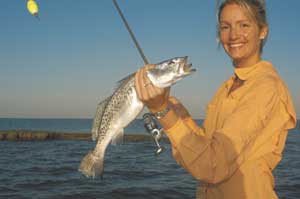
Each year outdoor sporting-equipment manufacturers develop new products appealing to the 21st century outdoorsman. But are new products so much better than the older existing models? That’s certainly a question open for debate.
Instances of lures becoming so popular everyone casts them, and fish, accordingly, learning to turn up their noses at them are legion. On the other hand, who’d doubt an ancient, jointed Creek Chub (the bass lure of George Perry, who caught a world’s No 1, 22-pounds, 4-ounces largemouth in 1932) still wouldn’t tempt a lunker?
Lure manufacturers continually improve their product lines to mostly sell more lures and make more money. Not to say the new lure colors, shapes, and sizes aren’t an improvement, but the main focus is to increase sales.
It’s a well-known bromide among lure-makers that new, improved colors and styles of fish-getters are designed, in most instances, to catch anglers, not necessarily fish.
But the proof ultimately is always in the pudding — or the fish’s mouth. If a lure doesn’t catch fish, it may have a short run of popularity before fading into obscurity or infamy. The Flying and Helicopter lures apparently flew away because of just such reasons.
Generally, I’ve learned staples in tackle and proven color regimes provide me with the best success.
However, a new no-gimmick lure has arrived upon the scene. Berkley Lures of Spirit Lake, Iowa, corralled a strategic group of people together and developed a revolutionary line of soft baits that may be changing artificial bait fishing.
Would you ever have thought an artificial lure would be more appealing to actual fish than live bait?
During the early 1980s, Fish Formula and Gator Bait broke the mold and incorporated a fourth dimension into artificial-lures. At the time, a lot of anglers came to believe fish would no longer have a chance. But we learned this new sensory approach was still incomplete.
Since then, artificial-bait manufacturers have continued to engineer lures to enhance the sensory component, in effect creating lures that are more appealing to fish because of the addition of salt, fish oils, and other chemicals.
During the last 20 years, Berkley’s team of chemical engineers, fish-behavior specialists, and the company’s pro staff, broke the mold by developing a new line of baits, the Gulp Baits.
Berkley engineered the Gulp line of soft baits from a biodegradable non-plastic material embedded with a water-soluble scent signature.
These lures are constructed of natural materials and attract fish that trigger them to feed. The company claims the lure leaves an intense scent trail that is more than 400 times more powerful than plastic baits and even more intense than live bait.
Berkley claims its field tests have proven Gulp lures are more effective than live bait. In fact, Gulp lures are more durable than live bait.
They come in many shapes and colors and seem to appeal to all species of fish, including fresh and saltwater game fish.
For previous decades, artificial lures incorporated a two- to three- dimensional approach.
Previously, artificial-lure designs appealed only to three of a fish’s senses — visual, auditory and tactile.
Many lures, such as crank baits and spoons, only appealed to two of the three components. But relying on strictly visual stimulation can be tricky.
Poor water clarity and instances of low-light penetration in combination with most fishes’ poor sense of sight often causes one-dimensional, good-looking lures to fail. The addition of sound sometimes triggers fish to strike, but the same sound during different conditions can repel every fish in a region.
Some days when fish are hungry, they’ll feed based on sight alone. Unfortunately, fish will discontinue their active feeding cycle and will become finickly at times.
That’s when the fourth dimension comes into play.
In order for an artificial lure to successfully convince a finicky predatory fish to strike and consume a lure, it must look, feel, sound, and taste/smell just like the original, with smell probably being the most important factor.
The scent trail, especially in areas of current, will attract fish from great distances. An explosion of scent has a better chance of drawing inquisitive predatory fish into an area and trigger strikes.
Fred Rourk of Sweet Tea Charters at Georgetown regularly uses Berkley’s Gulp Lures. He primarily fishes for redfish from his 18-foot Hewes Bonefisher.
As the redfish congregate in the backcountry flats during winter, they sometimes will become finicky and a motionless presentation becomes a necessity. Rourk especially likes Gulp lures during such days.
“Gulp is like fishing bait,” he said. “It can be (dead sticked) with no movement, or fished like a lure.”
As technology advances, new lures will come and go, but Berkley’s Gulp should continue to dupe even the most finicky fish — especially for anglers who believe in them strongly, such as Rourk.
He said he believes these lures are a definite improvement of past soft-plastic baits and most anglers would do well to have them in their tackle boxes.




Be the first to comment